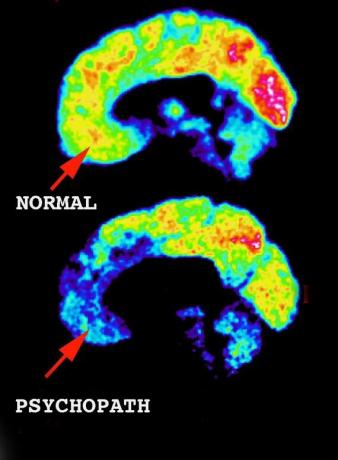The genetic and biological bases of psychopathy
We often talk about the acts, the style of behavior and the way of interacting with people that people have who could be described as psychopaths. Despite that, there is one question that is even more disturbing than all these topics: what are psychopaths indoors? What are the peculiarities of your own body that make you predisposed to psychopathy?
Trying to answer these questions is, deep down, address research on the biological bases of psychopathy.
So let's start by talking about what we know about their genetic characteristics.
Genetic findings on psychopathy
The strongest evidence for genetics often comes from twin studies and adoptions. According to these studies, heritability in children or adolescents in antisocial behavior is estimated at 30-44%.
In criminal adult subjects, there is a 69% concordance for monozygotic twins (the same egg, therefore almost identical genetic load) and 0.33% for dizygotic (two ovules), which gives conclusive evidence that there is a weight of genetics in criminal behavior above the environment. Numerous studies support these results.
It has also been shown that Y chromosome would be involved in the aggressiveness, thus being attributed to a greater aggressiveness in men than in women, in general.
The MAO-A gene
The MAO-A gene is up to date, the only clear example of how a specific mutation
it can alter behavior. This altered gene was found in people suffering from a psychopathic disorder and, in addition, in abused children as young.
In other words, the alteration of this gene predisposes to violent behavior. Conversely, people who have high concentrations of this gene from birth are less likely to develop antisocial problems.
The interesting thing about this finding is that it could help explain why not all victims of abuse when they grow up do the same to other people, for example.
Neuroanatomical findings
In the late 1990s, a study was conducted comparing the brain activity of 41 normal subjects and 41 murderers. Criminals were found to have less activity in the prefrontal region (the human region par excellence), which would translate into:
Neurologically: loss of inhibition of regions such as the amygdala, responsible (among others) for the regulation of aggressive feelings.
Behaviorally: risky, irresponsible, rule-breaking, violent, impulsive behaviors ...
Socially: lack of empathy for other people.

Neurochemical findings
Numerous experiments have shown the crucial role of serotonin as a modulator of aggressive behavior, the relationship being the following: the less serotonin, the more aggressive behavior is reinforced. Therefore, it would be easy to conclude that people suffering from this disorder could have altered serotonergic pathways.
In the same way that norepinephrine, dopamine, GABA and nitric oxide would be implicated in impulsive and violent behaviors, although with less relevance.
Neuroendocrine findings
On the hormonal level, the ones we have the most conclusive evidence for is insulin and testosterone. Certain studies show that if we have a low level of glucose, and therefore insulin in the blood, we are more predisposed to violent and impulsive behaviors.
In the case of testosterone, we have multiple studies comparing criminals and healthy people, where they show that the amount of free testosterone in the blood is increased in the first. In addition, various investigations indicate that women with higher testosterone are more sexually active, competitive, male, and alcohol users compared to women with low levels of alcohol is.
Psychophysiological findings
Cleckley (1976) proposed that psychopaths might have the ability to understand the literal (denotative) meaning of language, but not its emotional (connotative) meaning. They would therefore have an emotional deficit.
In addition, psychopaths would have altered emotional reactivity since, compared to normal people, in situations they should feel anxiety Y afraid, they don't feel it.
Likewise, they also have an absence in the startle reaction to the exposure of visually unpleasant content, and very high pitched and shrill beeps.
Based on all these data, psychopaths were proposed to have a weak brain inhibitory system, and a strong activation system. This would explain his impulsiveness and his inability to think about future consequences.
In conclusion...
The antisocial personality disorder is characterized by its lack of empathy and remorse for the violation of the rights of others and social norms, high impulsiveness and aggressiveness... They are subjects who will do whatever is necessary, regardless of the consequences, to achieve their purposes and benefits. personal.
But is the psychopath made or born? The answer is... a combination of both options. A marginal environment, where the person is born neglected, with violence, abuse, abandonment... has a crucial influence. However, it has been shown by numerous studies, that there is more genetic weight.
A clear proof of this would be obtained through the question... why are there people who, in the face of abuse, become abusive people, while others, no? This answer would be given by the amount of mao-A gene that person has a base. This could also respond to many other situations in which there are people who succumb to the situation and commit violent acts, while others refuse to do so.
We conclude then, a clear and evident biological role of the brain in antisocial personality disorder and a genetic-environment interaction (with more genetic relevance).
Bibliographic references:
- Caspi, A., McClay, J.; Moffitt, T., Mill, J. and Martin, J. (2002). Role of genotype in the cycle of violence in maltreated children. American Association for the Advancement of Science. 297 (5582): 851-854.
- Garrido, V. (2003). Psychopaths and other violent criminals. Valencia: Tirant lo Blanch.
- Ros, S., Peris, M.D. and Gracia, R. (2003) Impulsivity. Barcelona: Ars Medica.
- American Psychiatric Association, APA (2002). DSM-IV-TR. Diagnostic and Statistical Manual of Mental Disorders. Revised text. Barcelona: Masson.
- Francisco, J. (2000). Biological bases of psychopathologies. Madrid: Pyramid Psychology.
- World Health Organization (1998). ICD-10. Mental and behavioral disorders. Multiaxial version for adults. Geneva: WHO.
- Pelegrín, C. and Tirapu, J. (2003). Neurobiological bases of aggressiveness. Intersalud. Taken from: http://hdl.handle.net/10401/2411
